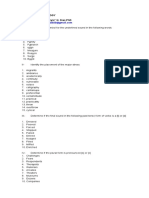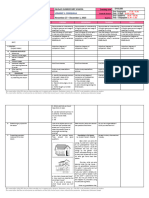Topic 5
Topic 5
Uploaded by
medelyncortes05Copyright:
Available Formats
Topic 5
Topic 5
Uploaded by
medelyncortes05Copyright
Available Formats
Share this document
Did you find this document useful?
Is this content inappropriate?
Copyright:
Available Formats
Topic 5
Topic 5
Uploaded by
medelyncortes05Copyright:
Available Formats
Adverbs of Frequency
Adverbs of Frequency are adverbs of time that answer the question "How frequently?" or "How
often?". They tell us how often something happens. Here are some examples:
a. daily, weekly, yearly
b. often, sometimes, rarely
You probably see a difference between a) and b) above. With words like daily we know exactly
how often. The words in a) describe definite frequency. On the other hand, words like often give us
an idea about frequency but they don't tell us exactly. The words in b)
describe indefinite frequency.
We separate them into two groups because they normally go in different positions in the sentence.
Adverbs of Definite Frequency
Examples:
hourly, daily, weekly, monthly, yearly
every second, once a minute, twice a year
once, twice, once or twice, three times
Adverbs of definite frequency, like all adverbs of definite time, typically go in END position. Look
at these examples:
Most companies pay taxes yearly.
The manager checks the toilets every hour.
The directors meet weekly to review progress.
Sometimes, usually for reasons of emphasis or style, some adverbs of definite frequency may go at
the FRONT, for example:
Every day, more than five thousand people die on our roads.
Adverbs of Indefinite Frequency
Look at these examples of adverbs of indefinite frequency:
100% always, constantly
usually, normally
frequently, regularly
often
50% sometimes
occasionally
rarely, infrequently
seldom
hardly ever
0% never
Adverbs of indefinite frequency mainly go in MID position in the sentence. They go before the
main verb (except the main verb "to be"):
We usually go shopping on Saturday.
I have often done that.
She is always late.
Occasionally, sometimes, often, frequently and usually can also go at the beginning or end of a
sentence:
Sometimes they come and stay with us.
I play tennis occasionally.
Rarely and seldom can also go at the end of a sentence (often with "very"):
We see them rarely.
John eats meat very seldom.
Activity N°1 choose the correct adverb of frequency
1. Andrea lives next door so we _______________________ see her.
never often rarely
2. Nancy and I [30%] _________________________ go out for coffee together.
never frequently occasionally
3. We meet ______________________ at the Annual General Meeting.
never every day yearly
4. My doctor ____________________________ .
yearly checks my health checks yearly my health checks my health yearly
5. It [0%] _____________________ rains here in the summer.
never sometimes rarely
6. ____________________ (0%) we take the dog off his leash at the beach.
Sometimes Never Rarely
7. My sister ___________________________ two days of school in a row.
often has missed has missed often has often missed
8. My boyfriend and I take vacations together quite (0%) _______________________________ .
never hardly frequently
9. Andy [10%] ____________________________ gets to visit with his cousins.
very frequently very rarely very often
10. I don't earn much because I ________________________________ .
never went to college
went never to college
went to college never
You might also like
- Simple Present Tense With Adverb of FrequencyDocument11 pagesSimple Present Tense With Adverb of FrequencyTrie Akhyarie RoemadhonNo ratings yet
- Adverbs of Frequency: English Grammar RulesDocument2 pagesAdverbs of Frequency: English Grammar RulesKarim Joshua EspañaNo ratings yet
- Adverbs of FrequencyDocument4 pagesAdverbs of FrequencySofia BarraganNo ratings yet
- Adverbs of FrequencyDocument3 pagesAdverbs of FrequencyYay06aNo ratings yet
- Adverbs of FrequencyDocument6 pagesAdverbs of FrequencyDana FiorellaNo ratings yet
- Adverbs of Frequency - EnglishClub PDFDocument2 pagesAdverbs of Frequency - EnglishClub PDFInés Amaya DíazNo ratings yet
- Adverbs of FrequencyDocument3 pagesAdverbs of FrequencyHilmarVargasNo ratings yet
- Adverbs of FrequencyDocument10 pagesAdverbs of FrequencyPatricia PierreNo ratings yet
- 2 English6Q2Week4Document25 pages2 English6Q2Week4MELISSA PANAGANo ratings yet
- Adverbs of Time ListDocument4 pagesAdverbs of Time ListMîss ÇhocolatëNo ratings yet
- Adverbs of FrequencyDocument2 pagesAdverbs of FrequencyJeyson LopezNo ratings yet
- Adverbs of Frequency 2020Document3 pagesAdverbs of Frequency 2020Sofia Salas100% (1)
- Adverbs of FrequencyDocument5 pagesAdverbs of FrequencyPapa Martelo MarteloNo ratings yet
- Adverbs of FrequencyDocument3 pagesAdverbs of FrequencyFederico Gustavo Salinas JimenezNo ratings yet
- Adverbs of FrequencyDocument4 pagesAdverbs of FrequencynatalylunaNo ratings yet
- 21 VerbosDocument2 pages21 VerbosRenzo MendezNo ratings yet
- B UoE Unit 13 PDFDocument22 pagesB UoE Unit 13 PDFEnrique HuacchaNo ratings yet
- Adverbs of FrequencyDocument1 pageAdverbs of Frequencycarmelita_starNo ratings yet
- 3 3 3 3Document7 pages3 3 3 3spacepumpkinNo ratings yet
- Adverbs of FrequencyDocument4 pagesAdverbs of FrequencyEdwards Leon ParedesNo ratings yet
- Frequency AdverbsDocument7 pagesFrequency AdverbsSteven ColladoNo ratings yet
- Let S Review:: "How Often Do You See Your Friends?"Document3 pagesLet S Review:: "How Often Do You See Your Friends?"gastonNo ratings yet
- Activity # 4 Adverbs of FrecuencyDocument3 pagesActivity # 4 Adverbs of FrecuencySandra Mireya PAEZ RODRIGUEZNo ratings yet
- Adverbs of FrequencyDocument1 pageAdverbs of FrequencyJody Vaughn LawrenceNo ratings yet
- Frequency AdverbsDocument4 pagesFrequency AdverbsAlexander ScrNo ratings yet
- Adverbs of FrequencyDocument2 pagesAdverbs of Frequencyinmacarmonam1700100% (10)
- Adverbs of Frequency Are Used To Say How Often We Do SomethingDocument2 pagesAdverbs of Frequency Are Used To Say How Often We Do Somethingcarmelita_starNo ratings yet
- Adverbs of FrequencyDocument6 pagesAdverbs of FrequencyLan PhamNo ratings yet
- Adverbs of Frequency - Explicação e ExercícioDocument3 pagesAdverbs of Frequency - Explicação e ExercícioRafael Azevedo da SilvaNo ratings yet
- Frequency AdverbsDocument4 pagesFrequency AdverbsLuis CuichanNo ratings yet
- Frequency AdverbsDocument1 pageFrequency AdverbsKenia RivasNo ratings yet
- Actividad Semana 2.1 Grado NovenoDocument5 pagesActividad Semana 2.1 Grado NovenoNicolas GamboaNo ratings yet
- Frequency Adverbs: Mr. Diaz Medical English IIDocument10 pagesFrequency Adverbs: Mr. Diaz Medical English IIlakjdlkaNo ratings yet
- Adverbs FrequencyDocument4 pagesAdverbs FrequencyManuel SilvaNo ratings yet
- ADVERBS of FREQUENCY Recurso Lengua 2 (Teoría)Document6 pagesADVERBS of FREQUENCY Recurso Lengua 2 (Teoría)emiiguaymaaas100% (1)
- Frequency Adverbs and ExpressionsDocument4 pagesFrequency Adverbs and ExpressionsOsiris I Gonzalez FelixNo ratings yet
- Book AdverbsDocument27 pagesBook AdverbsGina QuinonesNo ratings yet
- Frequency AdverbsDocument6 pagesFrequency AdverbsJean Pierre Pacheco TamarizNo ratings yet
- How Often Doyougoto The Cinema? Sometimes. Once A MonthDocument8 pagesHow Often Doyougoto The Cinema? Sometimes. Once A MonthMaria Soledad UrquilloNo ratings yet
- Adverbs of FrequencyDocument7 pagesAdverbs of FrequencyAndreea Dragomir0% (1)
- Info 16Document3 pagesInfo 16APGNo ratings yet
- Adverbs of Frequency: Often, Always,: Sometimes, EtcDocument3 pagesAdverbs of Frequency: Often, Always,: Sometimes, EtcAisNo ratings yet
- Workshop 4 Adverbs of FrequencyDocument3 pagesWorkshop 4 Adverbs of Frequencyrafael bautistaNo ratings yet
- Adverbs of Frequency 1Document2 pagesAdverbs of Frequency 1Dick B.50% (2)
- Actividad I para Grado 8o.Document4 pagesActividad I para Grado 8o.Sidia Esther Rodriguez EscamillaNo ratings yet
- Frequency Adverbs: Uses Word Order ExercisesDocument11 pagesFrequency Adverbs: Uses Word Order Exerciseschess tomanNo ratings yet
- Adverbs of FrequencyDocument3 pagesAdverbs of FrequencynmcNo ratings yet
- Adverbs of Frequency BLACKDocument3 pagesAdverbs of Frequency BLACKBrianNo ratings yet
- Present SimpleDocument4 pagesPresent SimpleartongNo ratings yet
- Day 2 Adverb of Frequency L2 (CDC) Teac and StuDocument8 pagesDay 2 Adverb of Frequency L2 (CDC) Teac and StuEdison PonceNo ratings yet
- Adverbs of FrequencyDocument4 pagesAdverbs of FrequencySharmila Devi RamachandaranNo ratings yet
- Adverbs of FrequencyDocument3 pagesAdverbs of FrequencyPradumna Singh KanhpuriyaNo ratings yet
- Adverbs of Frequency 2020Document1 pageAdverbs of Frequency 2020Rolando AlmengorNo ratings yet
- Tare N1 .. Adverbios. Liz Arostegui PDFDocument2 pagesTare N1 .. Adverbios. Liz Arostegui PDFDavid Manuel Chagua RojasNo ratings yet
- How To Keep Yourself Productive In Stressful Working ConditionsFrom EverandHow To Keep Yourself Productive In Stressful Working ConditionsNo ratings yet
- My Self-Care Plan: 12 Monthly Strategies That Will Transform Your LifeFrom EverandMy Self-Care Plan: 12 Monthly Strategies That Will Transform Your LifeNo ratings yet
- Tuesday 210323 ADocument6 pagesTuesday 210323 AAlexander Pérez QuispeNo ratings yet
- Cambridge IGCSE ™: French 0520/42 October/November 2022Document12 pagesCambridge IGCSE ™: French 0520/42 October/November 2022riddhima kapoorNo ratings yet
- Daily Routine PreviewDocument5 pagesDaily Routine PreviewCaro MartinezNo ratings yet
- Godišnji Plan I Program Za 5 RazredDocument3 pagesGodišnji Plan I Program Za 5 RazredMajda SoftićNo ratings yet
- Writers Effect WorkbookDocument35 pagesWriters Effect WorkbookKayleen MNo ratings yet
- Class 5th EnlishDocument4 pagesClass 5th EnlishRajesh kuamrNo ratings yet
- MG1-1 U4 L3 GrammarDocument36 pagesMG1-1 U4 L3 Grammarzainah fenaisNo ratings yet
- 10 Le1Document6 pages10 Le1amaterasu.sendaiNo ratings yet
- Clauses ReasonDocument3 pagesClauses ReasonJorge ARZNo ratings yet
- Nawesabi EnglishDocument320 pagesNawesabi EnglishchristfortressfamilychurchNo ratings yet
- Unit 07 Inventions LBDocument10 pagesUnit 07 Inventions LBemisselierNo ratings yet
- Guia4 - Inglés 10 - 2020Document7 pagesGuia4 - Inglés 10 - 2020miguel beltranNo ratings yet
- Final Exam in Phonology Prepared By: Annabelle"Kyla" N. Diaz, PHDDocument3 pagesFinal Exam in Phonology Prepared By: Annabelle"Kyla" N. Diaz, PHDELMER G. CARBONNo ratings yet
- Grade 9-SA1 TTDocument1 pageGrade 9-SA1 TTAiman AnsariNo ratings yet
- Unit 10Document5 pagesUnit 10Stefany CedeñoNo ratings yet
- Grammar 3 (Complete Course)Document26 pagesGrammar 3 (Complete Course)Abdelouahed El AbiNo ratings yet
- Session 5 Unit 8Document17 pagesSession 5 Unit 8LENIN ELVIN NAVARRO ALVAREZNo ratings yet
- Reflexive-pronouns ExplanationDocument2 pagesReflexive-pronouns ExplanationReem AliNo ratings yet
- English W-Sheet m1 w1Document4 pagesEnglish W-Sheet m1 w1Semaj RaviolaNo ratings yet
- Written Assignment and Marking SchemesDocument24 pagesWritten Assignment and Marking SchemesLoke Li YingNo ratings yet
- Actividades Transversal InglésDocument4 pagesActividades Transversal Inglésdeisy carolina perez becerraNo ratings yet
- Sentence Structure and Types of Sentences - Grammar - Academic Guides at Walden UniversityDocument6 pagesSentence Structure and Types of Sentences - Grammar - Academic Guides at Walden UniversityltraNo ratings yet
- Loraine - q2 WLP Week-4Document17 pagesLoraine - q2 WLP Week-4allisonkeating04No ratings yet
- Sentence Correction Solved 2000 To 2012Document14 pagesSentence Correction Solved 2000 To 2012Safdar AzizNo ratings yet
- English Journey A1.1 - Unit 1 - HelloDocument10 pagesEnglish Journey A1.1 - Unit 1 - HelloDouglas RamírezNo ratings yet
- English Block Syllabus 2023 - 2Document8 pagesEnglish Block Syllabus 2023 - 2Fakhra FirdousNo ratings yet
- Unit 1 Making Connections BE1 Part 1Document32 pagesUnit 1 Making Connections BE1 Part 1Durga Sri100% (1)
- 9026 31035 1 PBDocument13 pages9026 31035 1 PBmikasa ackermanNo ratings yet
- KS2 English 2022 Grammar Punctuation Spelling Paper 1 Short Answer QuestionsDocument32 pagesKS2 English 2022 Grammar Punctuation Spelling Paper 1 Short Answer QuestionsZayn Merchant DarNo ratings yet
- Verbs 1Document2 pagesVerbs 1Geziel FreitasNo ratings yet

























































































